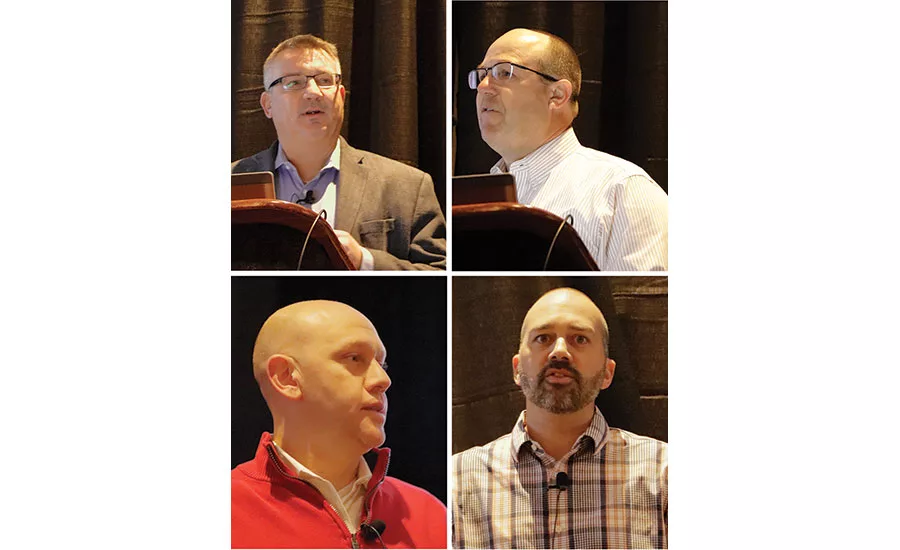Manufacturing News
Food and Beverage Companies Share Their Approaches to Digitalization

Three major food/beverage companies described their “digital transformations” at the Rockwell Automation Fair Food & Beverage Forum. While each described differing approaches to the digitalization process, all three—and those in the audience—are striving for the same goals, said moderator Dave Sharpe, Rockwell global industry director for consumer packaged goods.
Sharpe summed up some of these goals: “How do you improve asset utilization and yield, manage your workforce, then optimize resources to make sure you’re running efficiently, managing security risks … getting connected in a secure fashion and maintaining food safety?”
Mondelēz
Mondelēz has a strategic account with Rockwell Automation as a global automation and controls partner and service provider, which gives the company access to a dedicated Rockwell team, said Bob Pegher, NA regional automation manager for Mondelēz, during his presentation, “Implementation of a Data-Enabled Factory Floor.”
Mondelēz had a major project it called Integrated Digital Factory to upgrade its operations in 14 plants in the U.S., Mexico and Canada, including digital transformations of 50-plus production lines in 2017 and 2018.
Pegher noted that Mondelēz is already updating about 300 production lines worldwide. Major goals and challenges in North America included improving product quality, increasing lines’ global efficiency, reducing waste and providing the tools for workforce empowerment. The approach Mondelēz took to implement a data-enabled plant floor included building standards for: an industrial Ethernet; a hosting environment for manufacturing applications; a critical control network (CCN) architecture, topology and VLAN/IP schema; a methodology for collecting quality and machine performance data; and defining a system for commissioning, qualification and validation.
Rockwell’s network services engineers conducted a network assessment at each plant, including a control system audit, an as-is assessment, a risk analysis and recommendations. Mondelēz then received an assessment and recommendation report, CCN drawings and a BOM from Rockwell, which also provided a hosting-environment solution recommendation, said Pegher. In addition, Rockwell supplied a turnkey CCN installation and an industrial data center with all necessary hardware and software.
Pegher listed several benefits of the conversion, most importantly a consistent infrastructure across North America. “We now have a standard, consistent data collection methodology. Our quality teams now have real-time automated quality data from machines/processes.
Campbell Soup Company
Ted Franck, Campbell Soup Company director electrical and controls global engineering, described building a secure, robust and reliable plant floor infrastructure. “It was in 2015 when we started looking at our plant floor a little differently than we had in the past … In executing capital projects, there was more and more the need for the IT skill set,” said Franck. In operations, this was true as IT skills were needed for network expansion and security, remote support and data acquisition and MES.
With help from Rockwell, Campbell created a central governance team with cross-functional IT and OT skills and executed a detailed plant floor assessment and remediation plans at each of its manufacturing plants. Some of the results included creating a detailed standard architecture diagram and industrial Ethernet specifications, installing firewalls and managed switches, and eliminating public IP addresses, outdated operating systems and unmanaged switches.
Benefits included more efficient network monitoring/troubleshooting, use of modern security tools, closer relationships with IT and network SMEs when executing capital projects, and a central governance model for all future applications.
Jim Beam
Kevin Ludwig, senior electrical and controls engineer for Jim Beam, described the successes of implementing a Pavilion8 model predictive control (MPC) system in making bourbon. With Rockwell’s assistance, the company wanted to maximize throughput with shifting equipment and process constraints, reduce process and quality variance, and maintain recipe quality and tradition.
Did MPC work? Jim Beam was mostly a hands-on operation where operators adjusted steam flows, pressure, temperature, etc. “Pavilion allowed us to take some of those processes away from operators and let them focus on the tasks they should be focused on, like quality samples, scheduling batches, etc.,” said Ludwig. Improvements revealed a decrease in variance (standard deviation) in the low wine proof stage of 50 to 60 percent. With MPC managing distillation constraints, targets and material balance, plus key process constraints, Jim Beam has decreased steam usage, maximized beer-still feed and prevented alcohol loss.
Looking for a reprint of this article?
From high-res PDFs to custom plaques, order your copy today!








